| A | B |
|---|
| a unicellular organism that has a nucleus | protists |
| can produce its own food using its chloroplasts, sunlight, CO2 & H2O (producer) | autotroph |
| an organism that must eat other organisms to get food (consumer/predator/hunter) | heterotroph |
| mixotrophic protist with an eyespot, flagella, and chloroplasts to move and hunt or make food | euglena |
| autotropic protist with an eyespot, flagella, and chloroplasts to move & make food, lives in colonies | volvox |
| heterotrophic protist with cilia to move and sweep food into its oral groove | paramecium |
| heterotrophic protist with pseudopods to move and engulf food | amoeba |
| a false foot, cytoplasm that “reaches” out to move or engulf food for an Amoeba | pseudopods |
| a whip-like structure that moves back and forth to move Euglena and Volvox | flagella |
| short hair like structures that act like oars to move a Paramecium or move food into a Paramecium’s oral groove | cilia |
| organelle that can sense sunlight, used by Volvox and Euglena to move into light to make food | eyespot |
| organelle that digests hunted food for the paramcium | oral groove |
| the rigid outer boundary of a plant cell | cell wall |
| the semi-permeable inner boundary of a plant cell and the outside boundary of an animal cell | cell membrane |
| a structure inside a cell that serves a particular purpose | organelle |
| the “brain” of a cell that controls its daily activities and stores DNA | nucleus |
| separates the material in the nucleus from the cytoplasm | nuclear membrane |
| the storage area for food, water, and waste in a cell | vacuoles |
| green-pigmented organelles that capture sunlight and convert it into food for the cell | chloroplasts |
| organelles that break down food and release energy for the cell | mitochondria |
| a gel-like material inside the cell; it contains water and nutrients for the cell | cytoplasm |
| How are amoeba and paramecium similar and different? | Amoeba and paramecium are both heterotrophs, but amoeba use their pseudopods to move and hunt food while paramecium sweep food into their oral groove using their cilia. |
| How are amoeba and euglena similar and different? | Both can hunt for their food (heterotrophs), but euglena can also make their own food (autotroph) with its chloroplasts. Amoeba have pseudopods to move/eat, but euglena have flagella to move. |
| How are euglena and paramecium similar and different? | Both can hunt for their food (heterotroph), but euglena can also make their own food (autotroph) with its chloroplasts. Paramecium have cilia to move/eat, but euglena have flagella to move. |
| How are euglena and volvox similar and different? | Both can make their own food using chloroplasts (autotroph), but euglena can also hunt for their food. Both also use flagella to move, but volvox move together in colonies. |
| What organelles make plant and animal cells different from each other? | Plant cells have cell walls, chloroplasts, and fewer but larger vacuoles. Animal cells do not have cell walls or chloroplasts, and have more, smaller vacuoles. |
| How are plant and animal cells similar to each other? | Both have a nucleus, cytoplasm, cell membranes, and mitochondria. |
Which protist is this?,  | Amoeba,  |
Which protist is this?, 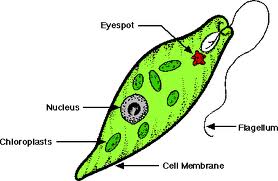 | Euglena,  |
Which protist is this?, 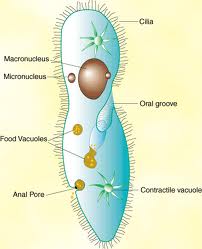 | Paramecium,  |
Which protist is this?, 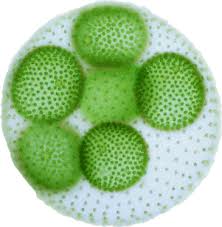 | Volvox,  |
Which cell type is this--plant or animal? Why?, 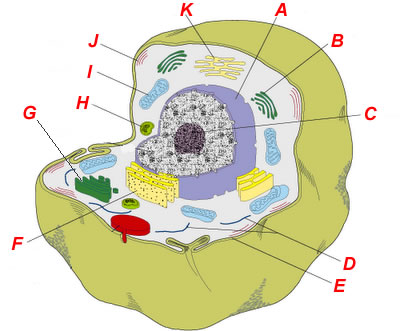 | Animal Cell--it only has a cell membrane as its outer boundary and has many small vacuoles. It has no chloroplasts.,  |
Which cell type is this--plant or animal? Why?, 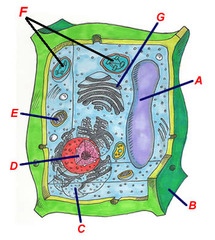 | Plant Cell--it has both a cell membrane and cell wall, chloroplasts, and fewer larger vacuoles.,  |
Which organelle is labeled "C" in this diagram?,  | The nucleus, the "brain" of the cell.,  |
Which organelle is labeled "I" in this diagram?,  | Mitochondria--the "mighty powerhouse" that breaks down stored food into energy for the cell.,  |
Which organelle is labeled "A" in this diagram?,  | Vacuole--a storage place for food, water, or waste in a cell.,  |
Which organelle is labeled "F" in this diagram?,  | Chloroplasts--green pigmented organelles that use sunlight, CO2 and water to produce food in plant cells.,  |
Which organelle is labeled "E" in this diagram?,  | Mitochondria--the "mighty powerhouse" that breaks down stored food into energy for the cell.,  |
| According to Cell Theory, cells are _____________, cells have _____________, and cells reproduce _________________. | Cells are the basic unit of life, cells have organelles that perform life functions, and cells reproduce from other cells. |